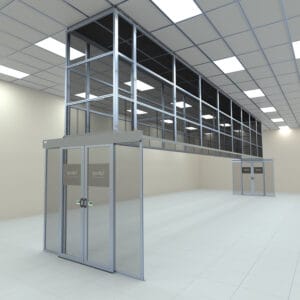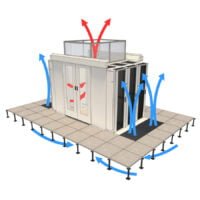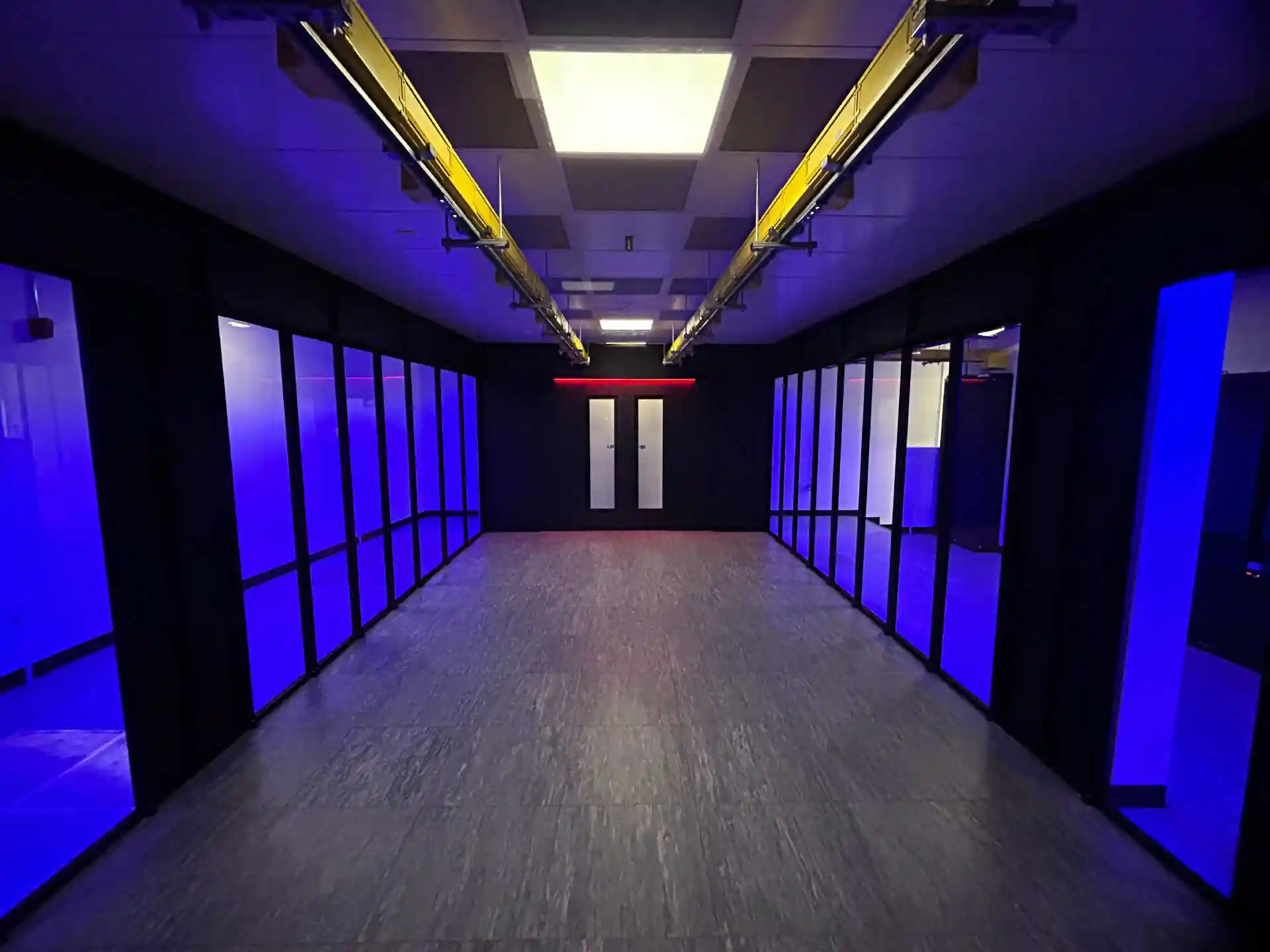Unlocking the Benefits of Hot Aisle Containment Systems
 In the rapidly changing world of data centres, efficiency and energy savings are paramount. One of the most effective ways to achieve this is through the implementation of hot aisle containment systems. As data centres change, it is important to understand the benefits of hot aisle containment. Knowing how it differs from cold aisle containment helps create an efficient and cost-effective solution.
In the rapidly changing world of data centres, efficiency and energy savings are paramount. One of the most effective ways to achieve this is through the implementation of hot aisle containment systems. As data centres change, it is important to understand the benefits of hot aisle containment. Knowing how it differs from cold aisle containment helps create an efficient and cost-effective solution.
This article will look at the benefits of hot aisle containment systems. It will explain how to improve cooling in data centres. It will also show ways to increase energy efficiency. Finally, it will discuss how to enhance the performance of your IT infrastructure.
This article will cover:
To understand the advantages of hot aisle containment systems, you must first learn what they involve.
Firstly, you need to understand the basic airflow dynamics within a typical data centre. Designers commonly arrange server racks in a hot-aisle/cold-aisle configuration. Servers draw cool air from the front, use it to cool their components, and then release hot exhaust air out the back.
If not managed well, hot exhaust air mixes with cool intake air. This raises the overall temperature and makes cooling systems less effective. This recirculation causes hotspots, increases energy consumption, and can lead to hardware failures.
HAC solves this problem by creating a “hot aisle.” This area directs hot exhaust air away from the equipment. The air goes straight back to the cooling units. You achieve this via a ceiling plenum return or by in-row coolers within cabinet rows.
A HAC system typically includes the following components:
- Roof Panels: Technicians attach these panels to the top of the racks to isolate the hot exhaust air. Depending on the cooling method used. The panels either direct the exhaust air towards the return ducts in the ceiling or contain the air within the aisle. In the latter, in-row coolers then cool the air and return it into the room as conditioned air.
- Aisle Doors: Doors at either end of the aisle prevent hot exhaust air from escaping. Often self-closing, these doors provide access while ensuring they close afterwards.
- In-Row Panels: Technicians fill gaps between racks. These gaps can be from missing racks, different rack heights, or building features. They use solid or flexible panels to seal these spaces.
By effectively isolating the hot exhaust air, HAC creates a more predictable and efficient cooling environment. In simple terms, it stops hot exhaust air from mixing with cold air. This helps the cooling units work better.
The cooling units can fill the data hall with cool, conditioned air. This keeps the equipment cool and prevents mixing with hot exhaust air. This process creates a more predictable and efficient cooling environment that maximises cooling capacity, boosts energy efficiency, and enhances cooling redundancy.
In their continuing pursuit of optimal performance and energy efficiency, data centre operators increasingly adopt practical airflow management strategies. Among the most popular, they implement hot aisle containment (HAC) and/or cold aisle containment (CAC).
Both systems aim to make cooling more efficient by stopping hot exhaust air from mixing with cold supply air. However, their methods and results differ. Data centre managers must understand these subtleties to properly adjust their environmental controls.
Data centre operators must deliver cool air to IT equipment. They also need to remove the warm air that the equipment creates.
If not managed well, these two air streams can mix. This can create hot spots and make cooling systems work harder, using more energy. That is where aisle containment strategies come into play.
Cold Aisle Containment
 Cold Aisle Containment (CAC) focuses on isolating cold supply air. CAC systems create a closed “cold aisle.” This aisle gets cool air from the Computer Room Air Conditioner (CRAC) or Computer Room Air Handler (CRAH) units.
Cold Aisle Containment (CAC) focuses on isolating cold supply air. CAC systems create a closed “cold aisle.” This aisle gets cool air from the Computer Room Air Conditioner (CRAC) or Computer Room Air Handler (CRAH) units.
CAC’s objective is to ensure that servers draw cool air from the enclosed aisle at the front of the racks. The IT equipment uses air to cool itself. It then pushes the warm air out from the back. This allows the warm air to mix with the room’s air.
Key Characteristics of CAC:
- Focus: Containing the cold supply air.
- Method: Enclosing the cold aisle where server rack fronts face each other.
- Hot Air Management: The system allows hot exhaust air to mix with ambient air within the hot aisles and the room.
- Benefit Illustration: Think of it as creating a “cold zone” that the IT equipment can directly benefit from.
Hot Aisle Containment
 On the other hand, Hot Aisle Containment isolates the hot exhaust air. HAC systems enclose the hot aisle located at the rear of server racks and directs the exhaust air back to the cooling units. Typically, hot, less-dense air rises, and the HAC system channels it via a return path in the ceiling plenum.
On the other hand, Hot Aisle Containment isolates the hot exhaust air. HAC systems enclose the hot aisle located at the rear of server racks and directs the exhaust air back to the cooling units. Typically, hot, less-dense air rises, and the HAC system channels it via a return path in the ceiling plenum.
Alternatively, in-row coolers cool the warm air within the aisle. HAC lowers the chance of hot spots. It also makes cooling more efficient by sending warmer air back to the cooling units.
Key characteristics of HAC:
- Focus: Containing the hot exhaust air.
- Method: Enclosing the aisles where server rack rears face each other.
- Cold Air Management: The system supplies cool air to the entire data hall, allowing IT equipment to draw it in.
- Benefit Illustration: Imagine a “heat chimney” that efficiently channels the hot exhaust air back to the cooling units.
Consequently, HAC and CAC differ by which airflow path they contain. Both strategies aim to make data centres more efficient. Data centre operators choose one based on factors like current infrastructure, rack density, cooling technology, and overall design. Unquestionably, they share the same goal: optimising a more energy-efficient and reliable data centre environment.
Without containment, conditioned air that cools equipment can mix with the hot exhaust air that the equipment expels. Furthermore, this mixing reduces cooling effectiveness and energy efficiency. HAC systems physically separate these two air streams, creating a more targeted and efficient cooling strategy.
The key benefits that make HAC systems indispensable for modern data centres:
- Better Cooling Efficiency: A HAC system cools more effectively. It does this by sending the exhaust air from IT equipment back to the cooling system. It stops air from mixing. This way, only the IT equipment uses the cool air from the cooling system.
- Reduced Energy Consumption: By optimising cooling efficiency, a HAC system significantly reduces a data centre’s energy consumption. This benefit is especially important for businesses aiming to minimise their carbon footprint and lower operating costs.
- Enhanced Equipment Performance: A HAC system maintains a consistent and optimal temperature for the IT equipment, ensuring it operates at peak performance. This leads to reduced downtime, improved reliability, and a longer equipment lifespan.
- Better Airflow Management: Hot aisle containment helps manage airflow in the data centre. It stops hot and cold air from mixing. This creates a more controlled and predictable environment, making it easier to monitor and maintain optimal cooling conditions.

The need for better energy efficiency and performance in data centres has made Hot Aisle Containment (HAC) very important. HAC systems improve cooling efficiency by keeping hot exhaust air away from cold supply air. This separation reduces energy use and makes equipment more reliable. However, while the benefits are compelling, a successful HAC implementation relies on a thorough understanding and careful consideration of key factors that include:
- Space Requirements: When considering HAC, space requirements demand immediate attention. Implementing a containment system increases the data centre’s physical footprint.
Beyond the containment structure itself, you must ensure adequate clearance. HAC aims to efficiently direct the exhaust air back to the cooling units.
This requires well-defined hot aisles with unimpeded pathways for air to travel. If these pathways do not have enough space, warm air can circulate again. This can reduce the benefits of containment and create hotspots. During the planning phase, you need to carefully assess the current rack layout, aisle widths, and available space. - Airflow Management: The ability to manage airflow effectively determines the success of any aisle containment system. This consideration involves multiple factors.
Firstly, the containment must robustly seal the space. Gaps and leaks in the barriers allow exhaust air to escape into cold aisles or let conditioned air enter hot aisles. This compromises thermal separation and reduces efficiency.
Secondly, the cooling system must adequately size and configured to manage the concentrated load of the hot aisle. By preventing mixing, HAC forces the cooling units to work with hotter return air.
This situation can raise the need for more cooling capacity. It may also require a review of the current cooling system. Proper airflow management needs correct placement of CRAC and CRAH units. This ensures they work well to receive the hot exhaust air. - Cost: Installing a HAC system can be costly. There is an initial cost for installation, which may require changes to existing infrastructure. There can also be ongoing operational expenses to consider.
Businesses should do a thorough analysis to determine the return on investment (ROI). This includes looking at potential energy savings, longer equipment life, and increased IT capacity. By understanding the fiscal impact, businesses can make informed decisions that align with their budget and strategic goals. - Expertise: Implementing a HAC system requires specialised knowledge and expertise. Collaborating with qualified experts who can design, install, and maintain the system to ensure optimal performance is vital.
These experts help you choose the right containment solution for your data centre. They ensure proper installation to reduce leaks. They also set up a strong maintenance schedule for long-term performance and energy efficiency. Without their expertise, even the most well-intentioned HAC implementation can fall short of its potential.
Using Hot Aisle Containment can improve data centre efficiency. However, operators need to consider key factors such as space, airflow, cost, and expertise. By planning and managing these areas well, data centre operators can fully benefit from HAC. This will help them create a more sustainable, reliable, and cost-effective future for their operations.
Conclusion
Hot aisle containment systems significantly boost cooling efficiency, reduce energy consumption, maximise equipment performance, and streamline airflow to improve data centre operations. When data centre operators know the difference between hot and cold aisle containment, they can make better choices. This helps them optimise their data centres, improve efficiency, and reduce their environmental impact.



